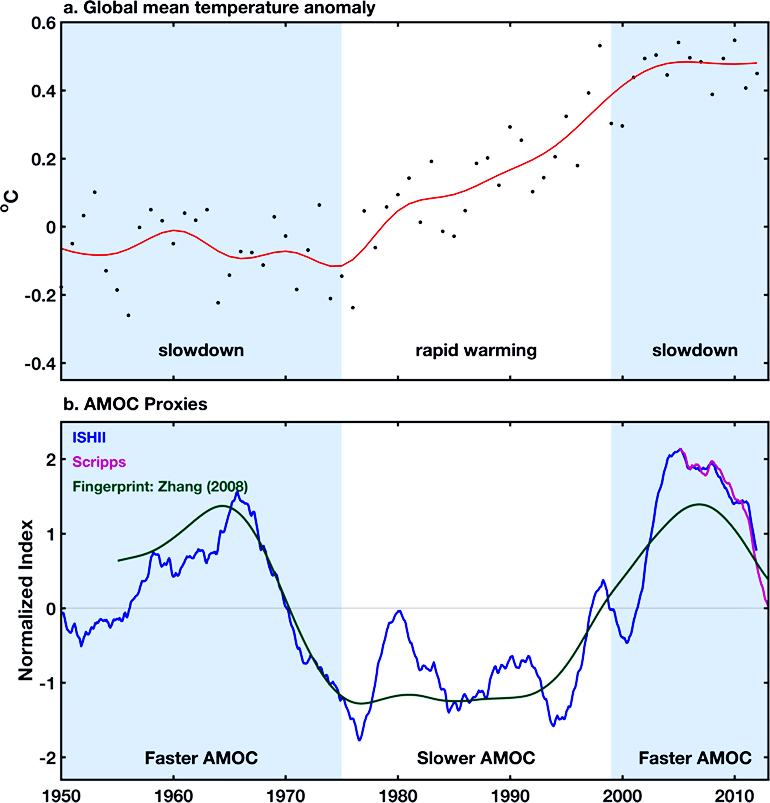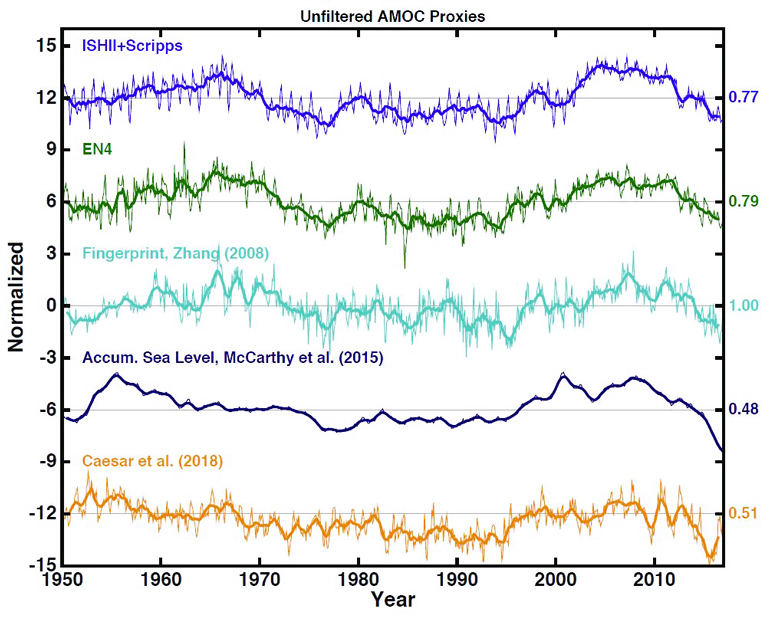The decline is 10 times larger than expected.
Global warming isn't the cause of slowdown in a huge circulation pattern in the Atlantic Ocean, which is, in fact, part of regular, decades-long cycle that will affect temperatures in coming decades, according to a new study.
DJS note: And so we have discovered another, probably natural, phenomenon which upsets the "CO2 is the climate's thermostat" narrative climate catastrophists have clung to for thirty years to frighten people. Add to this the other discoveries made over this time -- effects of patterns in the sun's magnetic field, natural aerosols released from plants and the oceans, multi-decadal oceanic oscillations -- and it is obvious by now that the CO2 bogeyman was always just a premature assumption arrogant minds still won't let go of. How many more discoveries -- and they are certainly out there, waiting to be found -- will it take before the doomsayers start to take climate science seriously?
Oceanographers are concerned about the long-term stability of the Atlantic Ocean circulation, and previous studies show that it has slowed dramatically in the past decade.
"Climate scientists have expected the Atlantic overturning circulation to decline long-term under global warming, but we only have direct measurements of its strength since April 2004. And the decline measured since then is 10 times larger than expected," says corresponding author Ka-Kit Tung, a professor of applied mathematics at the University of Washington with an adjunct appointment in atmospheric sciences.
 (Ka-Kit Tung/U. Washington)
(Ka-Kit Tung/U. Washington)The top panel shows global average surface temperature changes since 1950, with two periods of slower change and a period of rapid warming from 1975 to 2000.
The lower panels show the strength of the Atlantic overturning circulation. The blue (and, on the right, purple) curve is the salinity north of 45N, an indirect measure, or proxy, for the circulation strength. The green curve is an established proxy of the circulation.
"Many have focused on the fact that it's declining very rapidly, and that if the trend continues it will go past a tipping point, bringing a catastrophe such as an ice age. It turns out that none of that is going to happen in the near future. The fast response may instead be part of a natural cycle and there are signs that the decline is already ending."
A giant cycle
The results have implications for surface warming. The current's speed determines how much surface heat gets transferred to the deeper ocean, and a quicker circulation would send more heat to the deep Atlantic. If the current slows down, then it will store less heat, and Earth will be likely to see air temperatures rise more quickly than the rate since 2000.
"The global climate models can project what's going to happen long-term if carbon dioxide increases by a certain amount, but they currently lack the capability to predict surface warming in the next few decades, which requires a knowledge of how much the excess heat trapped by greenhouse gases is being absorbed by the oceans," Tung says.
The Atlantic Meridional Overturning Circulation, or AMOC, is a conveyor belt that brings surface water northward in the Atlantic; from there, the heavier salty water sinks and returns at depth from the Labrador and Nordic seas, near the North Pole, all the way south to the Southern Ocean.
Most people are interested in what happens at the surface – the Gulf Stream and associated Atlantic currents carry warmer water north, bringing mild temperatures to Western Europe.
The lines below show different ways of gauging the strength of the Atlantic overturning circulation. Direct monitoring only began in 2004, so other oceanic measures are needed to extend the dataset back to 1950.
 (Ka-Kit Tung/U. Washington)
(Ka-Kit Tung/U. Washington)But the new paper argues that the most important step, from a climate perspective, is what happens next. In the North Atlantic, the saltier water from the tropics sinks almost a mile (1,500 meters). As it does, it carries heat down with it away from the surface.
Changes in the strength of the AMOC affect how much heat leaves our atmosphere. The new study uses a combination of data from Argo floats, ship-based temperature measurements, tidal records, satellite images of sea-surface height that can show bulges of warm water, and recent high-tech tracking of the AMOC itself to suggest that its strength fluctuates as part of a roughly 60- to 70-year, self-reinforcing cycle.
When the current is faster, more of the warm, salty tropical water travels to the North Atlantic. Over years this causes more glaciers to melt, and eventually the freshwater makes the surface water lighter and less likely to sink, slowing the current.
When the AMOC is in a slow phase, the North Atlantic becomes cooler, ice melt slows, and eventually the freshwater melt source dries up and the heavier saltier water can plunge down again, which speeds up the whole circulation.
The new study argues that this current is not collapsing, but is just transitioning from its fast phase to its slower phase - and that this has implications for heating at the surface.
Looking to the past to predict the future
From 1975 to 1998, the AMOC was in a slow phase. As greenhouse gases were accumulating in the atmosphere, Earth experienced distinct warming at the surface.
From about 2000 until now, the AMOC has been in its faster phase, and the increased heat plunging in the North Atlantic has been removing excess heat from the Earth's surface and storing it deep in the ocean.
The new paper supports the authors' previous research showing that since 2000, during which observations show a slowdown in surface warming, heat has accumulated deep in the Atlantic Ocean. The new study shows this is the same period when Atlantic overturning circulation was in its fast phase.
Recent measurements of density in the Labrador Sea suggest the cycle is beginning to shift, Tung says.
That means that in coming years the AMOC will no longer be sending more of the excess heat trapped by greenhouse gases deep into the North Atlantic.
"The good news is the indicators show that this slowdown of the Atlantic overturning circulation is ending, and so we shouldn't be alarmed that this current will collapse any time soon," Tung says. "The bad news is that surface temperatures are likely to start rising more quickly in the coming decades."
The paper appears in Nature.
Additional authors are from the Ocean University of China and Qingdao National Laboratory of Marine Science and Technology. The US National Science Foundation, the Natural Science Foundation of China, the National Key Basic Research Program of China, and a Frederic and Julia Wan Endowed Professorship funded the study.
Source: University of Washington
This article was first published on Futurity. Read the original article.
